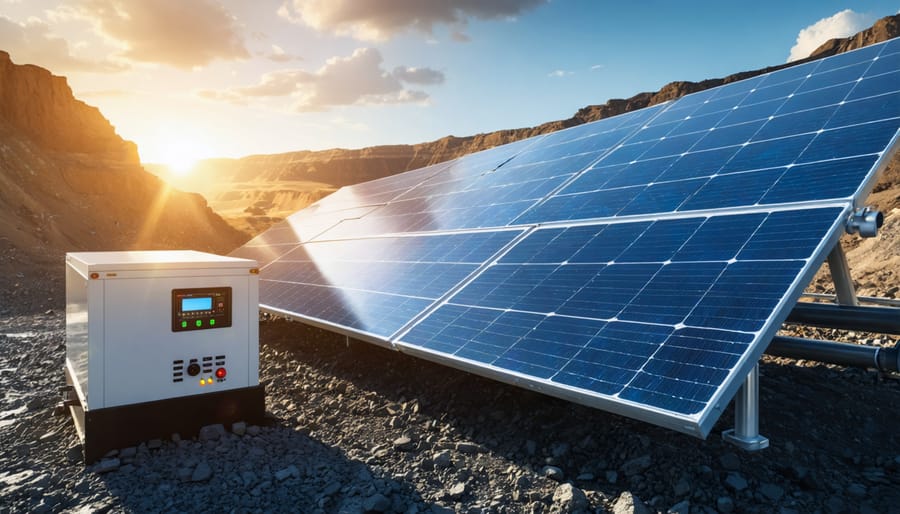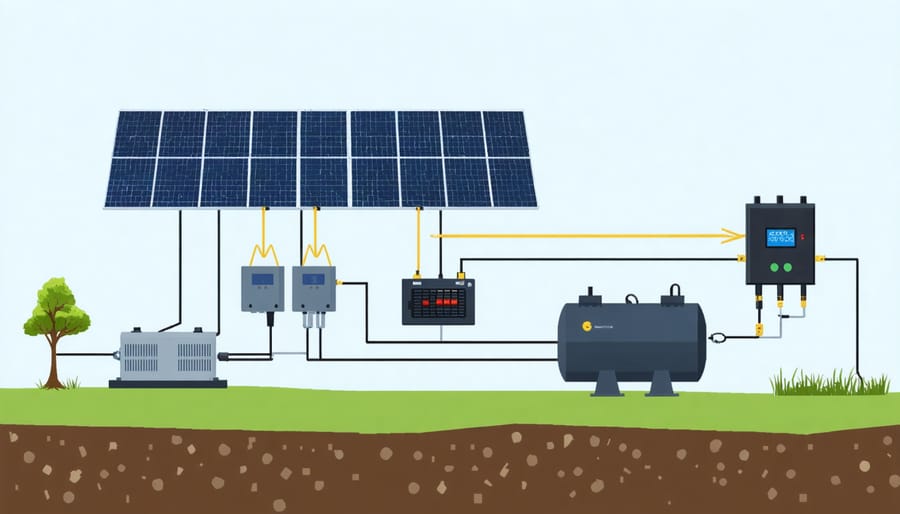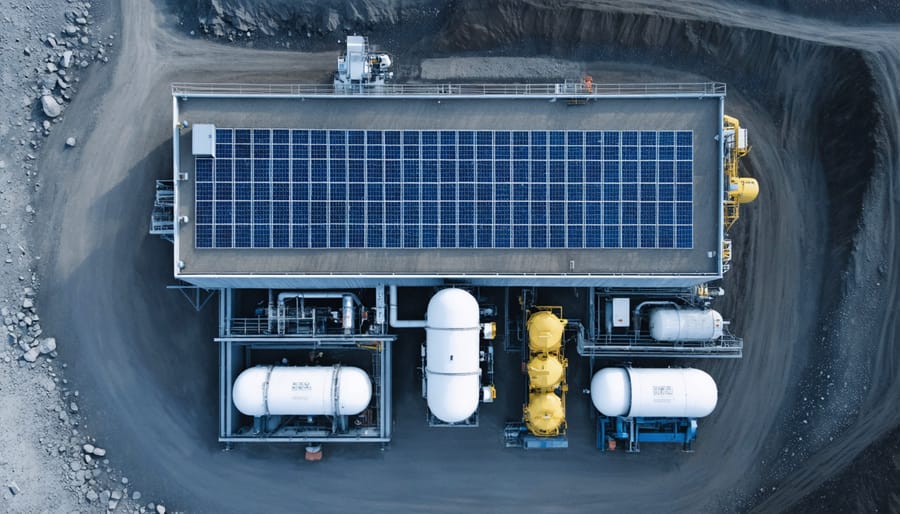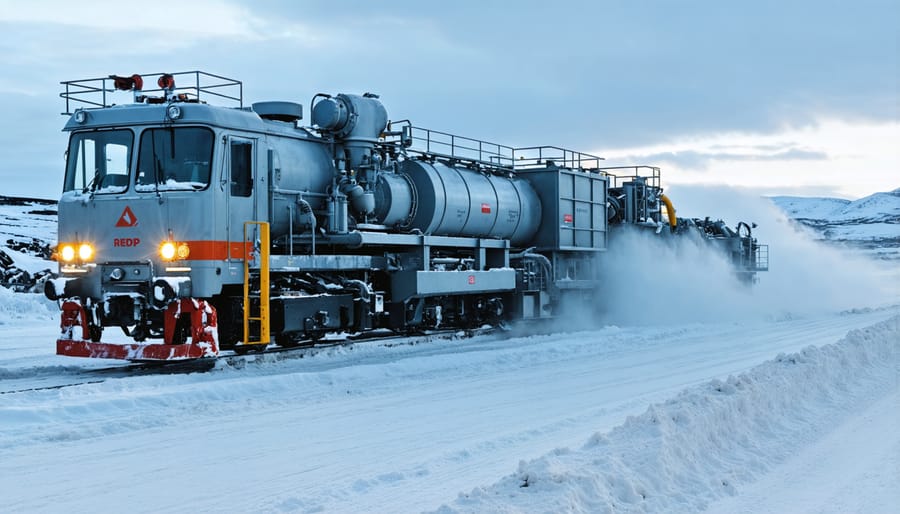Solar-Diesel Hybrid Systems Transform Mining Operations: Power When You Need It Most

Solar-diesel hybrid systems represent a groundbreaking shift in power generation, transforming the mining industry and remote industrial operations across Europe. By integrating photovoltaic arrays with conventional diesel generators, these hybrid solutions deliver up to 40% reduction in fuel consumption while ensuring uninterrupted power supply. The system’s intelligent control mechanisms automatically optimize between solar and diesel power, responding to real-time load demands and weather conditions.
Modern hybrid installations demonstrate remarkable versatility, particularly in mining operations where power requirements fluctuate dramatically throughout the day. With advanced energy management systems, these setups can seamlessly transition between power sources, maintaining stability while maximizing renewable energy utilization. The technology has evolved significantly, now offering sophisticated load-sharing capabilities and predictive maintenance features that ensure optimal performance in challenging environmental conditions.
For European industries seeking sustainable energy solutions, solar-diesel hybrid systems represent a practical bridge between conventional and renewable power generation, offering immediate carbon footprint reduction while maintaining the reliability of traditional power systems. This innovative approach aligns perfectly with EU sustainability goals while delivering tangible operational cost benefits.
Understanding Solar-Diesel Hybrid Systems
Key Components
A solar diesel hybrid system comprises four essential components that work together to deliver reliable and sustainable energy solutions. The solar array, consisting of high-efficiency photovoltaic panels, forms the primary power generation unit, converting sunlight into electricity. These panels are typically mounted on ground-based structures or rooftops, optimized for maximum solar exposure throughout the day.
The diesel generator serves as a dependable backup power source, ensuring continuous operation during periods of low solar radiation or increased power demand. Modern generators feature advanced fuel efficiency systems and smart-start capabilities that activate only when necessary.
Energy storage systems, primarily lithium-ion batteries, store excess solar power for later use. These batteries incorporate sophisticated battery management systems (BMS) to optimize charging cycles and extend operational lifespan.
The intelligent control system acts as the brain of the hybrid setup, managing power flow between components. It monitors real-time energy production, consumption patterns, and system health while automatically switching between power sources to maintain optimal efficiency and reliability.

System Integration
The seamless integration of solar panels, diesel generators, and control systems forms the backbone of a reliable hybrid power solution. At the heart of this integration lies an advanced control system that continuously monitors power demand, solar generation capacity, and battery state-of-charge. This intelligent system determines the optimal power source combination in real-time, ensuring uninterrupted power supply while maximizing solar energy utilization.
During peak sunlight hours, the system prioritizes solar power generation, directing excess energy to charge the battery storage system. When solar output decreases or energy demand exceeds solar generation, the control system smoothly transitions to battery power or activates the diesel generator as needed. This sophisticated load-sharing mechanism ensures optimal fuel consumption and reduces generator wear.
The integration also includes protective mechanisms that safeguard system components from voltage fluctuations and overload conditions. Modern hybrid systems feature remote monitoring capabilities, allowing operators to track performance metrics, schedule maintenance, and adjust system parameters from anywhere. This comprehensive integration approach delivers reliable power while maintaining system efficiency and extending equipment lifespan.
Benefits for Mining Operations

Financial Advantages
The integration of solar power with existing diesel systems presents compelling financial advantages for European businesses and industrial operations. Studies show that renewable energy in mining and other industrial applications can reduce fuel costs by 25-35% annually. This hybrid approach optimizes operational expenses through strategic load sharing between solar and diesel components.
Initial investment costs are typically recovered within 4-6 years, depending on system size and local solar conditions. For a standard 500kW installation, businesses can expect fuel savings of approximately €75,000-€100,000 annually, based on current European diesel prices. The reduced maintenance requirements of solar components, compared to diesel generators, further contribute to cost savings, with maintenance expenses decreasing by up to 20%.
Government incentives and carbon credit schemes across Europe can significantly improve the return on investment. Many EU member states offer tax benefits and grants for renewable energy adoption, potentially reducing the initial installation costs by 30-40%. The system’s ability to optimize fuel consumption during peak solar hours while maintaining reliable power supply translates to predictable operating costs and enhanced budget planning capabilities.
When factoring in the rising costs of diesel fuel and increasing carbon taxes, the long-term financial benefits become even more apparent, with some installations achieving complete return on investment in as little as 3 years.
Operational Benefits
Solar-diesel hybrid systems offer substantial operational advantages that make them increasingly attractive for European businesses and industries. The integration of solar power with existing diesel generators significantly improves system reliability through redundancy and smart load management. When solar energy is abundant, the system automatically reduces diesel generator usage, while seamlessly switching to diesel power during cloudy periods or nighttime operations.
This dual-power approach notably reduces the strain on diesel generators, extending their operational lifespan and decreasing maintenance requirements. Traditional diesel-only systems often suffer from excessive wear due to constant operation, but hybrid configurations allow generators to operate at optimal loads, minimising inefficient low-load running conditions.
The advanced monitoring and control systems integrated into modern hybrid solutions provide real-time performance data and predictive maintenance alerts. This proactive approach helps prevent unexpected breakdowns and optimises maintenance schedules, resulting in fewer emergency repairs and reduced downtime.
Furthermore, the modular nature of solar-diesel hybrid systems allows for easier maintenance procedures. Components can be serviced individually without shutting down the entire power supply, ensuring continuous operation. The reduced running hours of diesel generators also translate to extended service intervals, lower oil consumption, and decreased wear on mechanical parts.
These operational benefits contribute to a more reliable and cost-effective power solution, particularly beneficial for remote locations or facilities requiring uninterrupted power supply.
Implementation Strategies
Site Assessment
A thorough site assessment is crucial for designing an effective solar-diesel hybrid system. This process begins with a detailed analysis of the location’s solar potential, including annual sunlight hours, seasonal variations, and potential shading obstacles. Energy consultants evaluate the site’s geographical position, considering factors such as latitude, altitude, and local weather patterns to optimise solar panel placement and orientation.
The assessment also involves a comprehensive review of current and projected power requirements. This includes analyzing peak load demands, daily consumption patterns, and critical power needs. For industrial applications, particular attention is paid to load profiles during different operational phases, ensuring the hybrid system can maintain reliable power supply during both peak production times and lower-demand periods.
Technical evaluations extend to existing infrastructure, available space for solar arrays, and integration possibilities with current electrical systems. Environmental factors such as temperature variations, dust levels, and wind conditions are also considered, as these can impact both solar panel efficiency and diesel generator performance. This holistic approach ensures the final system design aligns perfectly with site-specific requirements and operational goals.
System Design
Optimizing a solar-diesel hybrid system requires careful consideration of multiple components to achieve maximum efficiency and reliability. The design process begins with a thorough assessment of energy requirements, including peak loads, daily consumption patterns, and seasonal variations. This data forms the foundation for determining the optimal ratio between solar capacity and diesel generator sizing.
The solar component typically consists of photovoltaic panels, inverters, and energy storage systems. Modern hybrid systems employ sophisticated power management systems that automatically switch between energy sources based on real-time demand and solar availability. The diesel generator serves as a reliable backup, ensuring continuous power supply during periods of low solar generation or increased demand.
Key design considerations include the integration of smart controllers that can seamlessly manage power flow between different sources, monitoring systems for performance optimization, and scalable architecture that allows for future expansion. European installations often incorporate weather-resistant components and advanced grid integration capabilities to comply with regional regulations.
For optimal performance, the system should include adequate battery storage capacity to maximize solar energy utilization and minimize diesel consumption. The design must also account for local climate conditions, available installation space, and maintenance requirements. Professional system designers typically use specialized software tools to model various configurations and predict system performance under different scenarios, ensuring the most cost-effective and efficient solution for each specific application.
Installation Considerations
Successful deployment of a solar-diesel hybrid system requires careful consideration of several key factors. Site assessment is crucial, including comprehensive solar resource evaluation and detailed analysis of existing power infrastructure. The system’s location should maximize solar exposure while considering space constraints and local building regulations.
Load profile analysis plays a vital role in determining optimal system sizing. This involves studying peak demand patterns, seasonal variations, and future growth projections to ensure the hybrid system meets both current and anticipated energy needs.
Grid connection capabilities and local regulatory requirements must be thoroughly evaluated. For European installations, compliance with specific regional standards and grid codes is essential. The integration of advanced control systems and monitoring equipment ensures seamless switching between solar and diesel power sources.
Environmental conditions such as temperature extremes, dust levels, and weather patterns influence component selection and maintenance requirements. Additionally, the installation should account for easy accessibility for maintenance personnel and include proper safety measures.
Storage solutions, whether battery-based or other technologies, should be carefully sized based on backup power requirements and operational strategy. This ensures reliable power supply during periods of low solar radiation or scheduled maintenance.
European Success Stories
Case Study: Nordic Metal Mine
Located in northern Sweden, the Boliden Aitik copper mine demonstrates the successful implementation of a solar-diesel hybrid system in extreme Arctic conditions. This pioneering installation, completed in 2019, combines a 3MW solar array with the existing diesel infrastructure to power critical mining operations.
The system was specifically designed to handle temperatures ranging from -40°C to +25°C while maintaining optimal performance. During the summer months, when the region experiences nearly 24 hours of daylight, the solar component provides up to 30% of the mine’s daily energy requirements, significantly reducing diesel consumption.
The hybrid system has demonstrated remarkable resilience and efficiency, achieving a 27% reduction in annual fuel consumption and cutting CO2 emissions by approximately 850 tonnes per year. The installation includes advanced control systems that seamlessly manage the transition between solar and diesel power, ensuring uninterrupted operations throughout the year.
What makes this case particularly noteworthy is its sophisticated energy management system, which uses predictive analytics to optimize power distribution based on weather forecasts and operational demands. The success of this installation has become a benchmark for similar projects in harsh climates, proving that solar-diesel hybrid systems can deliver reliable performance while contributing to sustainability goals, even in the most challenging environments.

Future Outlook
The future of solar-diesel hybrid systems looks increasingly promising as technological advancements continue to enhance system efficiency and reliability. With European industries leading the way in cutting costs and carbon emissions, we’re seeing rapid developments in smart integration technologies and energy management systems.
Emerging trends include the integration of artificial intelligence for predictive maintenance and optimal load management, advanced battery storage solutions with improved capacity and longevity, and sophisticated monitoring systems that enable real-time performance optimization. These innovations are making hybrid systems more efficient and cost-effective than ever before.
The development of more efficient solar panels, combined with improvements in inverter technology, is expected to further increase the solar component’s contribution to hybrid systems. This evolution will gradually reduce dependence on diesel generators, leading to more sustainable operations.
Industry experts anticipate that standardization of hybrid system components and installation procedures will make these solutions more accessible to a broader market. Additionally, the introduction of modular designs will allow for easier scaling and adaptation to varying power requirements, making these systems increasingly attractive for both industrial and commercial applications across Europe.
The integration of solar-diesel hybrid systems represents a transformative opportunity for mining operations seeking to enhance their sustainability profile while maintaining operational reliability. These systems have demonstrated their ability to significantly reduce fuel consumption, lower operational costs, and decrease carbon emissions without compromising power availability.
Through careful planning and implementation, mining companies can achieve fuel savings of 20-30% while simultaneously reducing their environmental impact. The success stories from various European mining operations highlight the practical viability of these hybrid solutions, particularly in remote locations where grid connectivity is limited or unreliable.
For mining operations considering the transition to a solar-diesel hybrid system, the path forward is clear. Begin with a comprehensive site assessment to determine solar potential and energy requirements. Engage with experienced system integrators who understand the unique challenges of mining operations. Consider starting with a pilot project to validate the concept before scaling up to full implementation.
The future of sustainable mining operations lies in embracing innovative power solutions. As technology continues to advance and costs decrease, solar-diesel hybrid systems will become increasingly attractive. Mining companies that act now position themselves at the forefront of industry innovation while building a more sustainable and cost-effective operation for the future.
Take the first step towards energy transformation by exploring how a solar-diesel hybrid system can benefit your mining operation. The combination of proven technology, environmental benefits, and economic advantages makes this an investment worth serious consideration.
Leave a Reply